Influence of the Depth of Nitrogen-Phosphorus Fertilizer Placement in Soil on Maize Yielding and Carbon Footprint in the Loess Plateau of China
Abstract
:1. Introduction
2. Materials and Methods
2.1. Experimental Site Description
2.2. Experimental Design and Practice Management
2.3. Biomass, N Uptake, Nitrogen Use Efficiency, and Maize Yield
2.4. Measurement Methods
2.5. System Boundaries and Functional Units
2.6. Measurement of Carbon Footprint and Nitrogen Footprint
2.7. Measurement of Net Ecosystem Economic Benefits (NEEBs) and per NEEB
2.8. Statistical Analyses
3. Results
3.1. Gaseous Nitrogen Emissions
3.2. Global Warming Potential and Greenhouse Gas Emission Intensity
3.3. Greenhouse Gas Emissions from Maize Field and Agricultural Inputs
3.4. Nr Losses from Maize Field and Agricultural Inputs
3.5. Carbon and Nitrogen Footprints and Net Ecosystem Economic Benefits
3.6. Maize Productivity
3.7. Relationship between Maize Productivity and Greenhouse Emission and Ammonia Volatilization
4. Discussion
4.1. Deep Fertilization Enhanced Soil CH4 Uptake and Decreased Gaseous N Emission
4.2. Deep Fertilization Decreased Carbon Footprint
4.3. Deep Fertilization Decreased Nitrogen Footprint
4.4. Effects of Deep Fertilization on Maize Productivity, NEEB, and the Technology Adoption Potential
5. Conclusions
Supplementary Materials
Author Contributions
Funding
Data Availability Statement
Conflicts of Interest
References
- Gan, Y.; Liang, C.; Wang, X.; McConkey, B. Lowering carbon footprint of durum wheat by diversifying cropping systems. Field Crops Res. 2011, 122, 199–206. [Google Scholar] [CrossRef]
- Cui, Z.; Zhang, H.; Chen, X.; Zhang, C.; Ma, W.; Huang, C.; Zhang, W.; Mi, G.; Miao, Y.; Li, X. Pursuing sustainable productivity with millions of smallholder farmers. Nature 2018, 555, 363–366. [Google Scholar] [CrossRef]
- Ma, R.; Yu, K.; Xiao, S.; Liu, S.; Ciais, P.; Zou, J. Data-driven estimates of fertilizer-induced soil NH3, NO and N2O emissions from croplands in China and their climate change impacts. Glob. Chang. Blol. 2022, 28, 1008–1022. [Google Scholar] [CrossRef] [PubMed]
- Maaz, T.M.; Sapkota, T.B.; Eagle, A.J.; Kantar, M.B.; Bruulsema, T.W.; Majumdar, K. Meta-analysis of yield and nitrous oxide outcomes for nitrogen management in agriculture. Glob. Chang. Blol. 2021, 27, 2343–2360. [Google Scholar] [CrossRef] [PubMed]
- You, L.; Ros, G.H.; Chen, Y.; Shao, Q.; Young, M.D.; Zhang, F.; De Vries, W. Global mean nitrogen recovery efficiency in croplands can be enhanced by optimal nutrient, crop and soil management practices. Nat. Commun. 2023, 14, 5747. [Google Scholar] [CrossRef]
- Young, M.D.; Ros, G.H.; de Vries, W. Impacts of agronomic measures on crop, soil, and environmental indicators: A review and synthesis of meta-analysis. Agric. Ecosyst. Environ. 2021, 319, 107551. [Google Scholar] [CrossRef]
- Cheng, Y.; Wang, H.-Q.; Liu, P.; Dong, S.-T.; Zhang, J.-W.; Zhao, B.; Ren, B.-Z. Nitrogen placement at sowing affects root growth, grain yield formation, N use efficiency in maize. Plant Soil 2020, 457, 355–373. [Google Scholar] [CrossRef]
- Zheng, Y.; Yue, Y.; Li, C.; Wang, Y.; Zhang, H.; Ren, H.; Gong, X.; Jiang, Y.; Qi, H. Revolutionizing Maize Crop Productivity: The Winning Combination of Zigzag Planting and Deep Nitrogen Fertilization for Maximum Yield through Root–Shoot Ratio Management. Agronomy 2023, 13, 1307. [Google Scholar] [CrossRef]
- Wu, P.; Liu, F.; Li, H.; Cai, T.; Zhang, P.; Jia, Z. Suitable fertilizer application depth can increase nitrogen use efficiency and maize yield by reducing gaseous nitrogen losses. Sci. Total Environ. 2021, 781, 146787. [Google Scholar] [CrossRef]
- Liu, T.; Fan, D.; Zhang, X.; Chen, J.; Li, C.; Cao, C. Deep placement of nitrogen fertilizers reduces ammonia volatilization and increases nitrogen utilization efficiency in no-tillage paddy fields in central China. Field Crops Res. 2015, 184, 80–90. [Google Scholar] [CrossRef]
- Gaihre, Y.K.; Singh, U.; Islam, S.M.; Huda, A.; Islam, M.; Satter, M.A.; Sanabria, J.; Islam, M.R.; Shah, A. Impacts of urea deep placement on nitrous oxide and nitric oxide emissions from rice fields in Bangladesh. Geoderma 2015, 259–260, 370–379. [Google Scholar] [CrossRef]
- Islam, S.M.; Gaihre, Y.K.; Biswas, J.C.; Singh, U.; Ahmed, M.N.; Sanabria, J.; Saleque, M. Nitrous oxide and nitric oxide emissions from lowland rice cultivation with urea deep placement and alternate wetting and drying irrigation. Sci. Rep. 2018, 8, 17623. [Google Scholar] [CrossRef] [PubMed]
- Liu, T.; Li, S.; Guo, L.; Cao, C.; Li, C.; Zhai, Z.; Zhou, J.; Mei, Y.; Ke, H. Advantages of nitrogen fertilizer deep placement in greenhouse gas emissions and net ecosystem economic benefits from no-tillage paddy fields. J. Clean. Prod. 2020, 263, 121322. [Google Scholar] [CrossRef]
- Su, W.; Liu, B.; Liu, X.; Li, X.; Ren, T.; Cong, R.; Lu, J. Effect of depth of fertilizer banded-placement on growth, nutrient uptake and yield of oilseed rape (Brassica napus L.). Eur. J. Agron. 2015, 62, 38–45. [Google Scholar] [CrossRef]
- Ke, J.; He, R.; Hou, P.; Ding, C.; Ding, Y.; Wang, S.; Liu, Z.; Tang, S.; Ding, C.; Chen, L. Combined controlled-released nitrogen fertilizers and deep placement effects of N leaching, rice yield and N recovery in machine-transplanted rice. Agric. Ecosyst. Environ. 2018, 265, 402–412. [Google Scholar] [CrossRef]
- Nakano, T.; Inoue, G.; Fukuda, M. Methane consumption and soil respiration by a birch forest soil in West Siberia. Tellus B 2004, 56, 223–229. [Google Scholar] [CrossRef]
- Fang, H.; Cheng, S.; Yu, G.; Cooch, J.; Wang, Y.; Xu, M.; Li, L.; Dang, X.; Li, Y. Low-level nitrogen deposition significantly inhibits methane uptake from an alpine meadow soil on the Qinghai–Tibetan Plateau. Geoderma 2014, 213, 444–452. [Google Scholar] [CrossRef]
- Nan, W.; Li, S.; Dong, Z.; Yao, P. CH4 fluxes and diffusion within soil profiles subjected to different fertilizer regimes on China’s Loess Plateau. Agric. Ecosyst. Environ. 2020, 287, 106679. [Google Scholar] [CrossRef]
- Xue, J.-F.; Pu, C.; Liu, S.-L.; Zhao, X.; Zhang, R.; Chen, F.; Xiao, X.-P.; Zhang, H.-L. Carbon and nitrogen footprint of double rice production in Southern China. Ecol. Indic. 2016, 64, 249–257. [Google Scholar] [CrossRef]
- He, S.; Chen, Y.; Xiang, W.; Chen, X.; Wang, X.; Chen, Y. Carbon and nitrogen footprints accounting of peanut and peanut oil production in China. J. Clean. Prod. 2021, 291, 125964. [Google Scholar] [CrossRef]
- Ledgard, S.F.; Wei, S.; Wang, X.; Falconer, S.; Zhang, N.; Zhang, X.; Ma, L. Nitrogen and carbon footprints of dairy farm systems in China and New Zealand, as influenced by productivity, feed sources and mitigations. Agric. Water Manag. 2019, 213, 155–163. [Google Scholar] [CrossRef]
- Wang, Z.-b.; Zhang, H.-l.; Lu, X.-h.; Wang, M.; Chu, Q.-q.; Wen, X.-y.; Chen, F. Lowering carbon footprint of winter wheat by improving management practices in North China Plain. J. Clean. Prod. 2016, 112, 149–157. [Google Scholar] [CrossRef]
- Li, B.; Fan, C.; Zhang, H.; Chen, Z.; Sun, L.; Xiong, Z. Combined effects of nitrogen fertilization and biochar on the net global warming potential, greenhouse gas intensity and net ecosystem economic budget in intensive vegetable agriculture in southeastern China. Atmos. Environ. 2015, 100, 10–19. [Google Scholar] [CrossRef]
- Liu, C.; Cutforth, H.; Chai, Q.; Gan, Y. Farming tactics to reduce the carbon footprint of crop cultivation in semiarid areas. A review. Agron. Sustain. Dev. 2016, 36, 69. [Google Scholar] [CrossRef]
- Wang, L.; Li, L.; Xie, J.; Luo, Z.; Zhang, R.; Cai, L.; Coulter, J.A.; Palta, J.A. Managing the trade-offs among yield, economic benefits and carbon and nitrogen footprints of wheat cropping in a semi-arid region of China. Sci. Total Environ. 2021, 768, 145280. [Google Scholar] [CrossRef]
- Zhang, D.; Shen, J.; Zhang, F.; Li, Y.; Zhang, W. Carbon footprint of grain production in China. Sci. Rep. 2017, 7, 4126. [Google Scholar] [CrossRef]
- Grassini, P.; Cassman, K.G. High-yield maize with large net energy yield and small global warming intensity. Proc. Natl. Acad. Sci. USA 2012, 109, 1074–1079. [Google Scholar] [CrossRef]
- Liang, L.; Ridoutt, B.G.; Lal, R.; Wang, D.; Wu, W.; Peng, P.; Hang, S.; Wang, L.; Zhao, G. Nitrogen footprint and nitrogen use efficiency of greenhouse tomato production in North China. J. Clean. Prod. 2019, 208, 285–296. [Google Scholar] [CrossRef]
- Xu, Q.; Hu, K.; Liang, H.; Leghari, S.J.; Knudsen, M.T. Incorporating the WHCNS model to assess water and nitrogen footprint of alternative cropping systems for grain production in the North China Plain. J. Clean. Prod. 2020, 263, 121548. [Google Scholar] [CrossRef]
- Xu, Y.; Wang, Y.; Ma, X.; Liu, X.; Zhang, P.; Cai, T.; Jia, Z. Ridge-furrow mulching system and supplementary irrigation can reduce the greenhouse gas emission intensity. Sci. Total Environ. 2020, 717, 137262. [Google Scholar] [CrossRef]
- Chen, Z.; Xu, C.; Ji, L.; Feng, J.; Li, F.; Zhou, X.; Fang, F. Effects of multi-cropping system on temporal and spatial distribution of carbon and nitrogen footprint of major crops in China. Glob. Ecol. Conserv. 2020, 22, e00895. [Google Scholar] [CrossRef]
- Lin, Z.-c.; Dai, Q.-g.; Ye, S.-c.; Wu, F.-g.; Jia, Y.-s.; Chen, J.-d.; Xu, L.-s.; Zhang, H.-c.; Huo, Z.-y.; Ke, X. Effects of nitrogen application levels on ammonia volatilization and nitrogen utilization during rice growing season. Rice Sci. 2012, 19, 125–134. [Google Scholar] [CrossRef]
- Zheng, J.; Wang, H.; Fan, J.; Zhang, F.; Guo, J.; Liao, Z.; Zhuang, Q. Wheat straw mulching with nitrification inhibitor application improves grain yield and economic benefit while mitigating gaseous emissions from a dryland maize field in northwest China. Field Crops Res. 2021, 265, 108125. [Google Scholar] [CrossRef]
- Yang, N.; Lü, F.; He, P.; Shao, L. Response of methanotrophs and methane oxidation on ammonium application in landfill soils. Appl. Microbiol. Biotechnol. 2011, 92, 1073–1082. [Google Scholar] [CrossRef]
- Chen, S.; Fu, W.; Cai, L.; Xing, Z.; Mou, B.; Wang, Y.; Wu, S.; Zhao, T. Metabolic diversity shapes vegetation-enhanced methane oxidation in landfill covers: Multi-omics study of rhizosphere microorganisms. Waste Manag. 2023, 172, 151–161. [Google Scholar] [CrossRef]
- Chen, X.; Ren, H.; Zhang, J.; Zhao, B.; Ren, B.; Wan, Y.; Liu, P. Deep phosphorus fertilizer placement increases maize productivity by improving root-shoot coordination and photosynthetic performance. Soil Tillage Res. 2024, 235, 105915. [Google Scholar] [CrossRef]
- Liu, J.; Xu, Y.; Zhu, Y.; Yin, W.; Fan, D.; Yan, G.; Raza, S.T.; Lu, Z.; Chen, Z. Enhanced soil methane oxidation in both organic layer and topsoil during the succession of subtropical forests. Process Saf. Environ. 2023, 170, 865–876. [Google Scholar] [CrossRef]
- Adviento-Borbe, M.A.A.; Linquist, B. Assessing fertilizer N placement on CH4 and N2O emissions in irrigated rice systems. Geoderma 2016, 266, 40–45. [Google Scholar] [CrossRef]
- Wang, Y.; Xu, Y.; Guo, Q.; Zhang, P.; Cai, T.; Jia, Z. Adopting nitrogen deep placement based on different simulated precipitation year types enhances wheat yield and resource utilization by promoting photosynthesis capacity. Field Crops Res. 2023, 294, 108862. [Google Scholar] [CrossRef]
- Liu, C.; Wang, Y.; Chen, H.; Sun, Q.; Jiang, Q.; Wang, Z. High level of winter warming aggravates soil carbon, nitrogen loss and changes greenhouse gas emission characteristics in seasonal freeze-thaw farmland soil. Sci. Total Environ. 2023, 905, 167180. [Google Scholar] [CrossRef]
- Deng, X.; Xu, T.; Xue, L.; Hou, P.; Xue, L.; Yang, L. Effects of warming and fertilization on paddy N2O emissions and ammonia volatilization. Agric. Ecosyst. Environ. 2023, 347, 108361. [Google Scholar] [CrossRef]
- Bhuiyan MS, I.; Rahman, A.; Loladze, I.; Das, S.; Kim, P.J. Subsurface fertilization boosts crop yields and lowers greenhouse gas emissions: A global meta-analysis. Sci. Total Environ. 2023, 876, 162712. [Google Scholar] [CrossRef]
- Peng, Y.; Wang, G.; Li, F.; Yang, G.; Fang, K.; Liu, L.; Qin, S.; Zhang, D.; Zhou, G.; Fang, H. Unimodal response of soil methane consumption to increasing nitrogen additions. Environ. Sci. Technol. 2019, 53, 4150–4160. [Google Scholar] [CrossRef] [PubMed]
- Aronson, E.; Helliker, B. Methane flux in non-wetland soils in response to nitrogen addition: A meta-analysis. Ecology 2010, 91, 3242–3251. [Google Scholar] [CrossRef]
- Chang, R.; Liu, X.; Wang, T.; Li, N.; Bing, H. Stimulated or inhibited response of methane flux to nitrogen addition depends on nitrogen levels. J. Geophys. Res.-Biogeosci. 2021, 126, e2021JG006600. [Google Scholar] [CrossRef]
- Xu, X.; Lan, Y. Spatial and temporal patterns of carbon footprints of grain crops in China. J. Clean. Prod. 2017, 146, 218–227. [Google Scholar] [CrossRef]
- Liu, W.; Zhang, G.; Wang, X.; Lu, F.; Ouyang, Z. Carbon footprint of main crop production in China: Magnitude, spatial-temporal pattern and attribution. Sci. Total Environ. 2018, 645, 1296–1308. [Google Scholar] [CrossRef] [PubMed]
- Zhang, G.; Liu, S.; Wang, X.; Wang, X.; Zhang, Y.; Zhao, D.; Wen, X.; Han, J.; Liao, Y. Mixed application of controlled-release urea and normal urea can improve crop productivity and reduce the carbon footprint under straw return in winter wheat-summer maize cropping system. Eur. J. Agron. 2023, 151, 127002. [Google Scholar] [CrossRef]
- Feng, X.; Sun, T.; Guo, J.; Cai, H.; Qian, C.; Hao, Y.; Yu, Y.; Deng, A.; Song, Z.; Zhang, W. Climate-smart agriculture practice promotes sustainable maize production in northeastern China: Higher grain yield while less carbon footprint. Field Crops Res. 2023, 302, 109108. [Google Scholar] [CrossRef]
- Jiang, Z.; Zhong, Y.; Yang, J.; Wu, Y.; Li, H.; Zheng, L. Effect of nitrogen fertilizer rates on carbon footprint and ecosystem service of carbon sequestration in rice production. Sci. Total Environ. 2019, 670, 210–217. [Google Scholar] [CrossRef]
- Gong, H.; Li, J.; Sun, M.; Xu, X.; Ouyang, Z. Lowering carbon footprint of wheat-maize cropping system in North China Plain: Through microbial fertilizer application with adaptive tillage. J. Clean. Prod. 2020, 268, 122255. [Google Scholar] [CrossRef]
- Zhang, X.-Q.; Pu, C.; Zhao, X.; Xue, J.-F.; Zhang, R.; Nie, Z.-J.; Chen, F.; Lal, R.; Zhang, H.-L. Tillage effects on carbon footprint and ecosystem services of climate regulation in a winter wheat–summer maize cropping system of the North China Plain. Ecol. Indic. 2016, 67, 821–829. [Google Scholar] [CrossRef]
- Xue, J.-F.; Yuan, Y.-Q.; Zhang, H.-L.; Ren, A.-X.; Lin, W.; Sun, M.; Gao, Z.-Q.; Sun, D.-S. Carbon footprint of dryland winter wheat under film mulching during summer-fallow season and sowing method on the Loess Plateau. Ecol. Indic. 2018, 95, 12–20. [Google Scholar] [CrossRef]
- Meng, C.; Wang, F.; Yang, K.; Shock, C.C.; Engel, B.A.; Zhang, Y.; Tao, L.; Gu, X. Small wetted proportion of drip irrigation and non-mulched treatment with manure application enhanced methane uptake in upland field. Agric. For. Meteorol. 2020, 281, 107821. [Google Scholar] [CrossRef]
- Ju, X.-T.; Xing, G.-X.; Chen, X.-P.; Zhang, S.-L.; Zhang, L.-J.; Liu, X.-J.; Cui, Z.-L.; Yin, B.; Christie, P.; Zhu, Z.-L. Reducing environmental risk by improving N management in intensive Chinese agricultural systems. Proc. Natl. Acad. Sci. USA 2009, 106, 3041–3046. [Google Scholar] [CrossRef] [PubMed]
- Li, S.; Hu, M.; Shi, J.; Tian, X.; Wu, J. Integrated wheat-maize straw and tillage management strategies influence economic profit and carbon footprint in the Guanzhong Plain of China. Sci. Total Environ. 2021, 767, 145347. [Google Scholar] [CrossRef] [PubMed]
- Cui, Y.; Khan, S.U.; Sauer, J.; Zhao, M. Exploring the spatiotemporal heterogeneity and influencing factors of agricultural carbon footprint and carbon footprint intensity: Embodying carbon sink effect. Sci. Total Environ. 2022, 846, 157507. [Google Scholar] [CrossRef] [PubMed]
- Dachraoui, M.; Sombrero, A. Effect of tillage systems and different rates of nitrogen fertilisation on the carbon footprint of irrigated maize in a semiarid area of Castile and Leon, Spain. Soil Tillage Res. 2020, 196, 104472. [Google Scholar] [CrossRef]
- Xue, J.-F.; Liu, S.-L.; Chen, Z.-D.; Chen, F.; Lal, R.; Tang, H.-M.; Zhang, H.-L. Assessment of carbon sustainability under different tillage systems in a double rice cropping system in Southern China. Int. J. Life Cycle Assess. 2014, 19, 1581–1592. [Google Scholar] [CrossRef]
- Wang, X.; Feng, Y.; Yu, L.; Shu, Y.; Tan, F.; Gou, Y.; Luo, S.; Yang, W.; Li, Z.; Wang, J. Sugarcane/soybean intercropping with reduced nitrogen input improves crop productivity and reduces carbon footprint in China. Sci. Total Environ. 2020, 719, 137517. [Google Scholar] [CrossRef]
- Wang, L.; Coulter, J.A.; Li, L.; Luo, Z.; Chen, Y.; Deng, X.; Xie, J. Plastic mulching reduces nitrogen footprint of food crops in China: A meta-analysis. Sci. Total Environ. 2020, 748, 141479. [Google Scholar] [CrossRef] [PubMed]
- Leach, A.M.; Galloway, J.N.; Bleeker, A.; Erisman, J.W.; Kohn, R.; Kitzes, J. A nitrogen footprint model to help consumers understand their role in nitrogen losses to the environment. Environ. Dev. 2012, 1, 40–66. [Google Scholar] [CrossRef]
- Zhang, S.; Lövdahl, L.; Grip, H.; Tong, Y.; Yang, X.; Wang, Q. Effects of mulching and catch cropping on soil temperature, soil moisture and wheat yield on the Loess Plateau of China. Soil Tillage Res. 2009, 102, 78–86. [Google Scholar] [CrossRef]
- Bai, J.; Li, Y.; Zhang, J.; Xu, F.; Bo, Q.; Wang, Z.; Li, Z.; Li, S.; Shen, Y.; Yue, S. Straw returning and one-time application of a mixture of controlled release and solid granular urea to reduce carbon footprint of plastic film mulching spring maize. J. Clean. Prod. 2021, 280, 124478. [Google Scholar] [CrossRef]
- Xia, L.; Lam, S.K.; Chen, D.; Wang, J.; Tang, Q.; Yan, X. Can knowledge-based N management produce more staple grain with lower greenhouse gas emission and reactive nitrogen pollution? A meta-analysis. Glob. Chang. Blol. 2017, 23, 1917–1925. [Google Scholar] [CrossRef]
- Yao, Y.; Zhang, M.; Tian, Y.; Zhao, M.; Zhang, B.; Zhao, M.; Zeng, K.; Yin, B. Urea deep placement for minimizing NH3 loss in an intensive rice cropping system. Field Crops Res. 2018, 218, 254–266. [Google Scholar] [CrossRef]
- Guan, X.-K.; Wei, L.; Turner, N.C.; Ma, S.-C.; Yang, M.-D.; Wang, T.-C. Improved straw management practices promote in situ straw decomposition and nutrient release, and increase crop production. J. Clean. Prod. 2020, 250, 119514. [Google Scholar] [CrossRef]
- Patuk, I.; Hasegawa, H.; Borodin, I.; Whitaker, A.C.; Borowski, P.F. Simulation for design and material selection of a deep placement fertilizer applicator for soybean cultivation. Open Eng. 2020, 10, 733–743. [Google Scholar] [CrossRef]
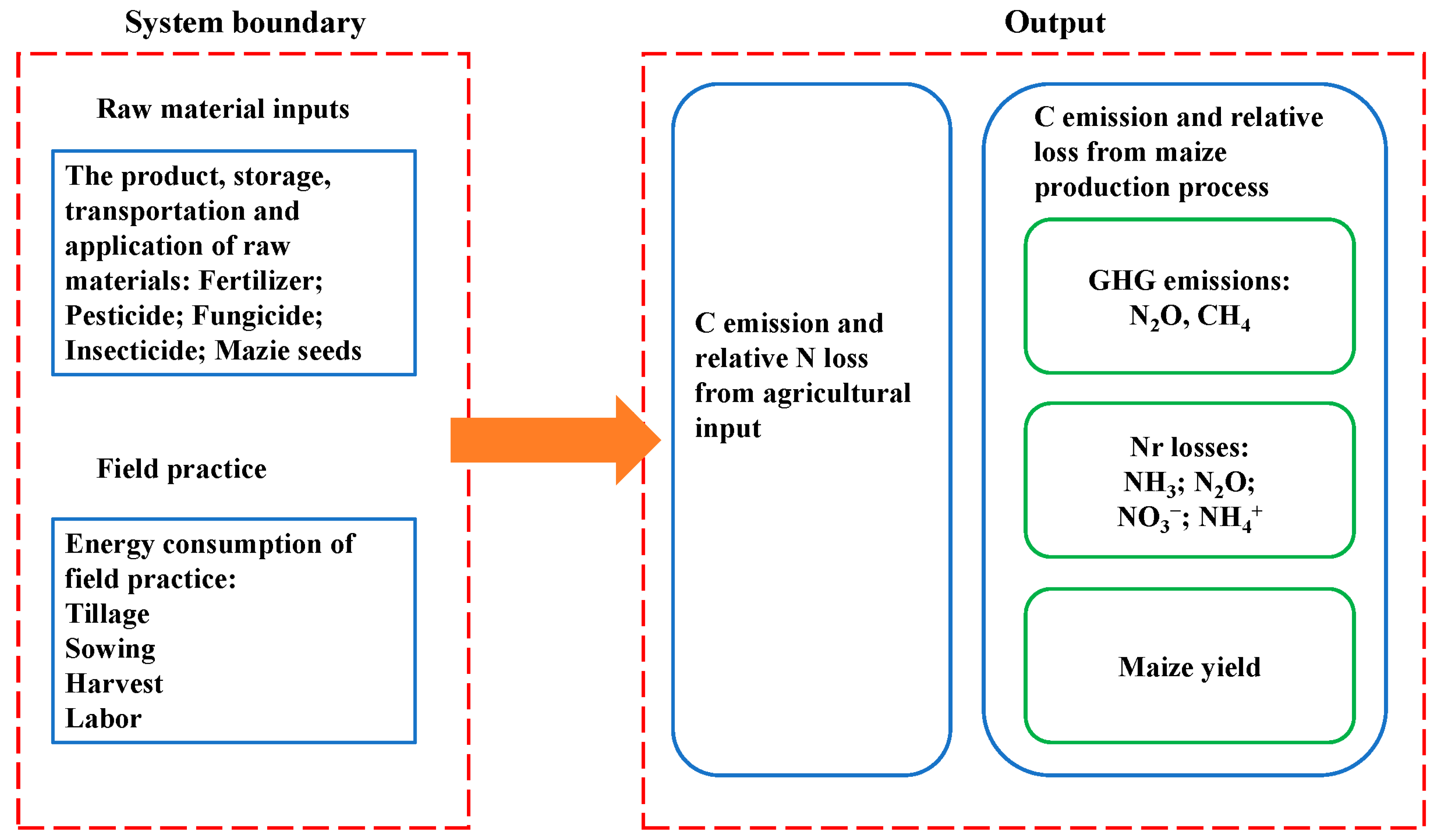
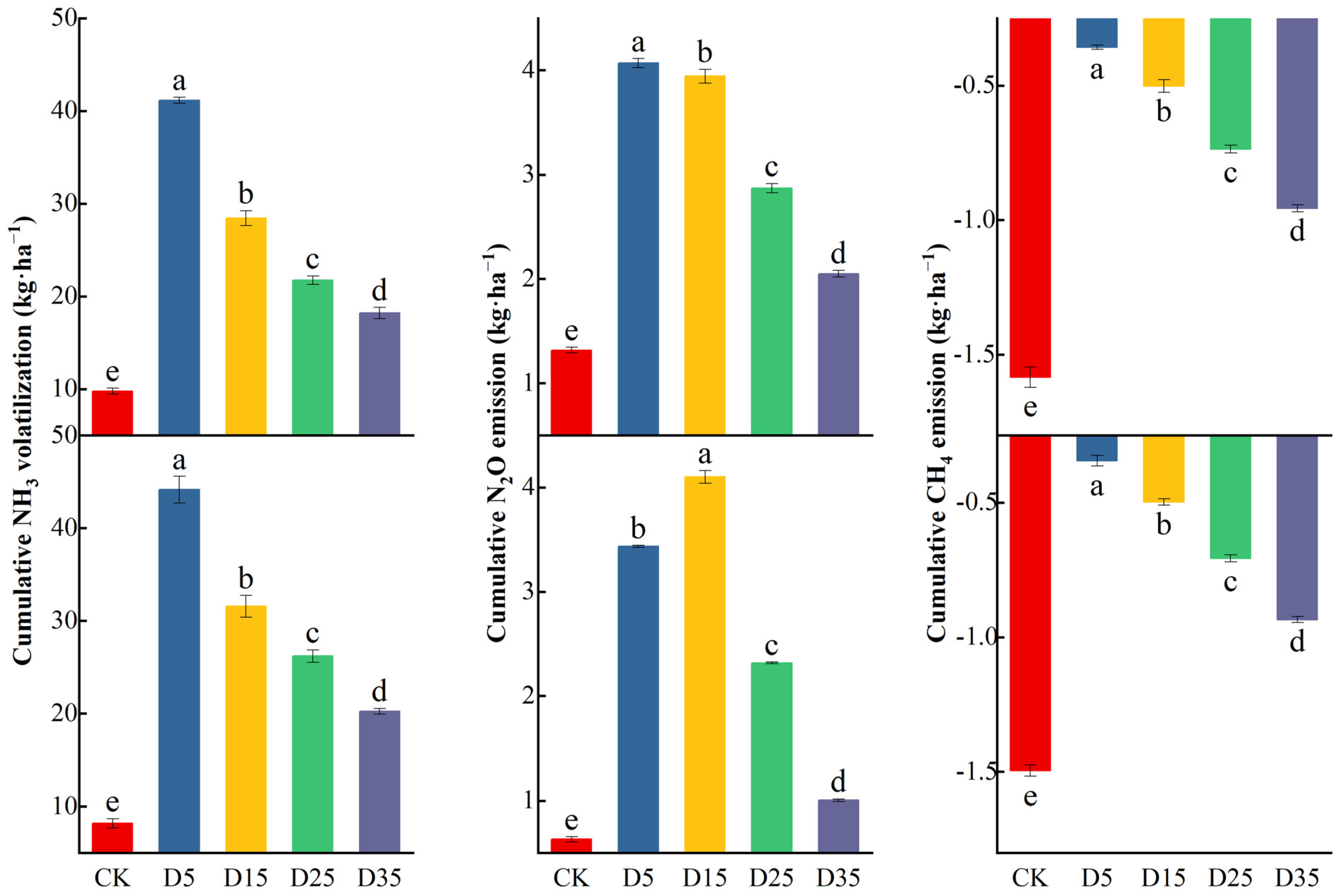
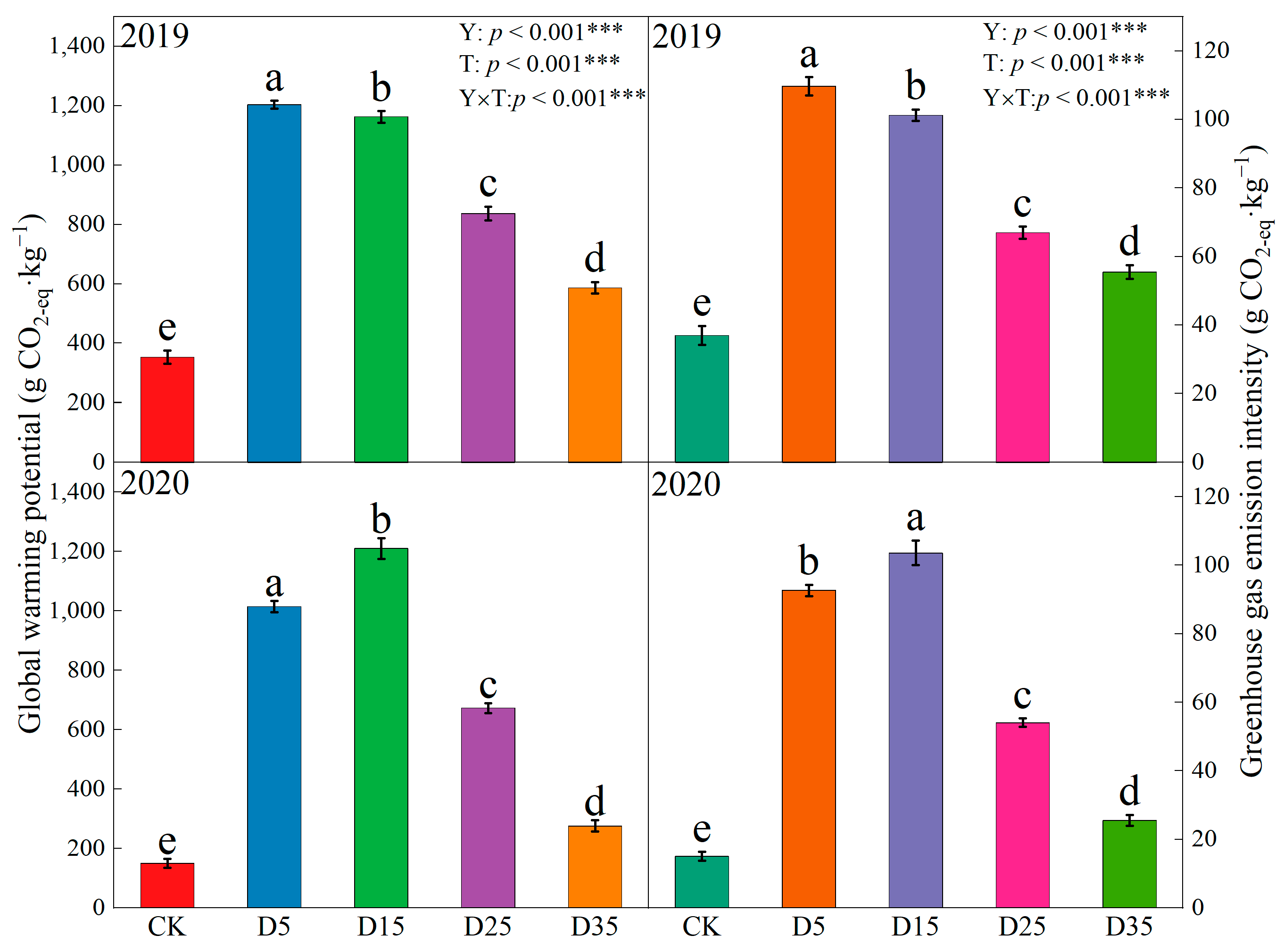

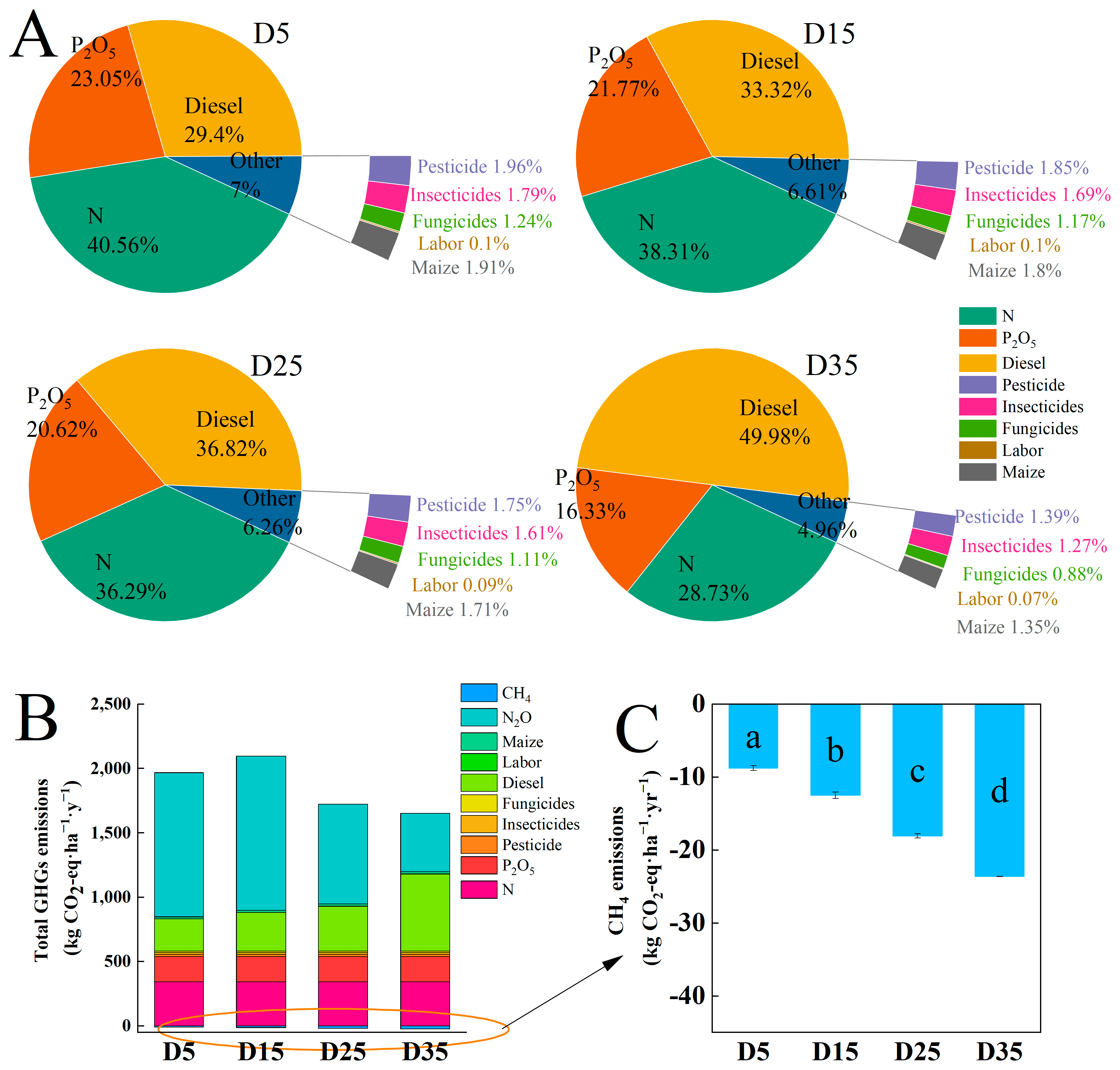
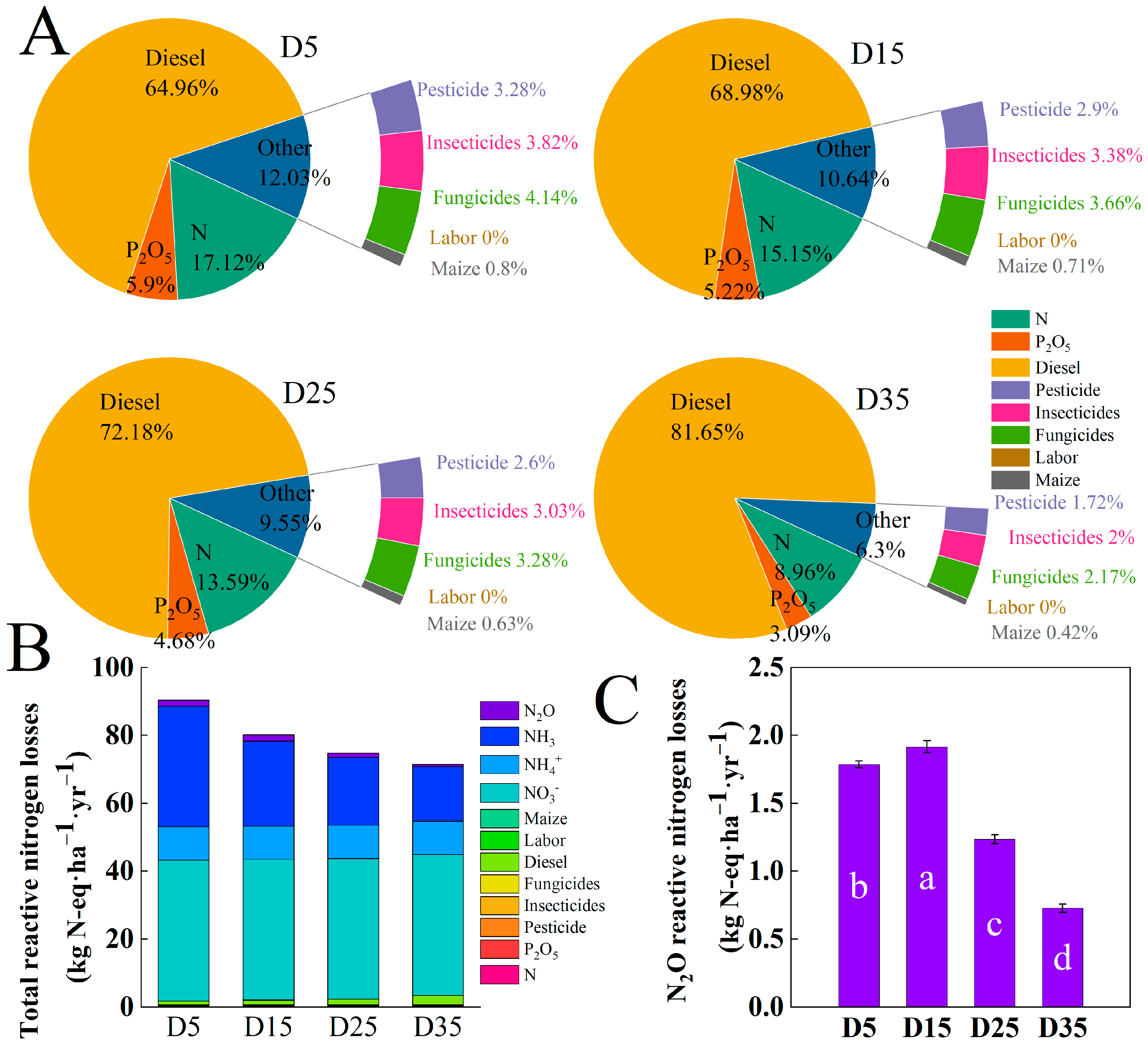


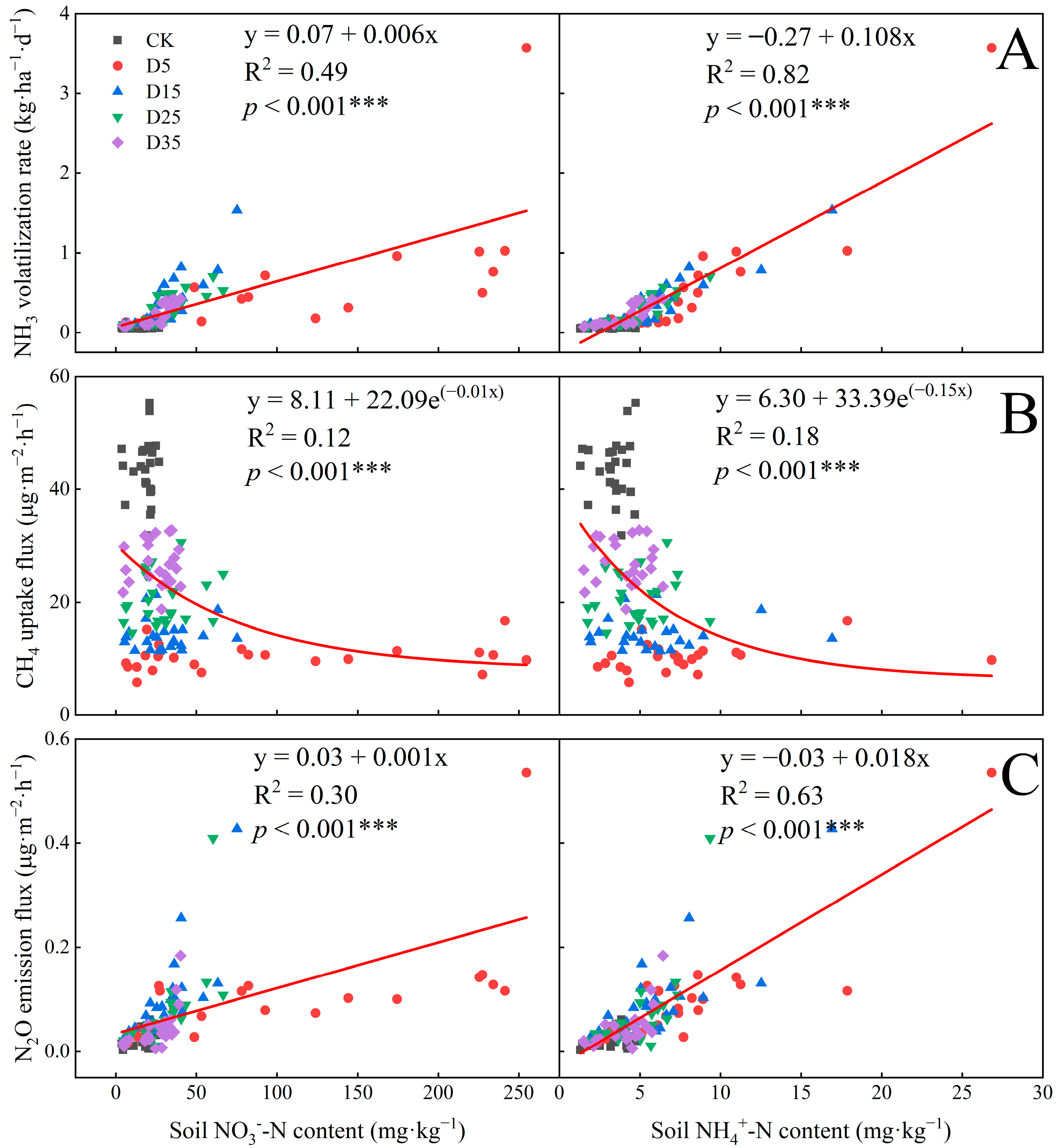
| Item | GHG Emissions | Nr Losses | Sources | Reference |
|---|---|---|---|---|
| Coefficient (CO2-eq) | Coefficient (N-eq) | |||
| N (kg·kg−1) | 1.53 | 0.89 × 10−3 | CLCD 0.7 | Chen et al., 2020 [31] |
| P2O5 (kg·kg−1) | 1.63 | 0.54 × 10−3 | ||
| Pesticide (kg·kg−1) | 16.61 | 3.53 × 10−3 | ||
| Insecticides (kg·kg−1) | 10.15 | 4.49 × 10−3 | ||
| Fungicides (kg·kg−1) | 10.5 | 7.05 × 10−3 | ||
| Diesel (kg·ha−1) | 4.99 | 4.66 × 10−3 | ||
| Labor (kg·person−1·day−1) | 0.86 | - | ||
| Maize (kg·kg−1) | 1.93 | 0.88 × 10−3 |
| Item | GHG Emissions (kg CO2-eq·ha−1) | ||||
|---|---|---|---|---|---|
| CK | D5 | D15 | D25 | D35 | |
| N | 0 | 344.25 | 344.25 | 344.25 | 344.25 |
| P2O5 | 0 | 195.60 | 195.60 | 195.60 | 195.60 |
| Pesticide | 16.61 | 16.61 | 16.61 | 16.61 | 16.61 |
| Insecticides | 15.23 | 15.23 | 15.23 | 15.23 | 15.23 |
| Fungicides | 10.50 | 10.50 | 10.50 | 10.50 | 10.50 |
| Diesel | 149.7 | 249.5 | 299.4 | 349.3 | 598.8 |
| Labor | 0.86 | 0.86 | 0.86 | 0.86 | 0.86 |
| Maize | 16.21 | 16.21 | 16.21 | 16.21 | 16.21 |
| Total | 209.11 | 848.76 | 898.66 | 948.567 | 1198.06 |
| Item | Nr Losses (g N-eq·ha−1) | ||||
|---|---|---|---|---|---|
| CK | D5 | D15 | D25 | D35 | |
| N | 0 | 306.38 | 306.38 | 306.38 | 306.38 |
| P2O5 | 0 | 105.62 | 105.62 | 105.62 | 105.62 |
| Pesticide | 58.63 | 58.63 | 58.63 | 58.63 | 58.63 |
| Insecticides | 68.36 | 68.36 | 68.36 | 68.36 | 68.36 |
| Fungicides | 74.03 | 74.03 | 74.03 | 74.03 | 74.03 |
| Diesel | 697.60 | 1162.67 | 1395.20 | 1627.74 | 2790.41 |
| Labor | - | - | - | - | - |
| Maize | 14.27 | 14.27 | 14.27 | 14.27 | 14.27 |
| Total | 912.89 | 1789.96 | 2022.50 | 2255.03 | 3417.70 |
| Year | Treatment | N Uptake | NUE | Biomass | Yield |
|---|---|---|---|---|---|
| kg·ha−1 | % | kg·ha−1 | kg·ha−1 | ||
| 2019 | CK | 88.21 d | 18,379.95 d | 9548.45 d | |
| D5 | 161.43 c | 32.54 c | 21,628.35 c | 10,971.43 bc | |
| D15 | 174.13 b | 38.19 b | 23,331.38 b | 11,487.09 b | |
| D25 | 187.19 a | 43.99 a | 25,237.00 a | 12,507.13 a | |
| D35 | 157.83 c | 30.94 c | 21,215.30 c | 10,588.24 c | |
| 2020 | CK | 82.61 d | 18,354.50 d | 9982.03 d | |
| D5 | 151.30 c | 30.53 c | 21,551.53 c | 10,951.10 c | |
| D15 | 163.84 b | 36.10 b | 22,463.023 b | 11,680.44 b | |
| D25 | 179.99 a | 43.28 a | 23,403.25 a | 12,447.11 a | |
| D35 | 146.81 c | 28.53 c | 21,255.70 c | 10,797.55 c | |
| ANOVA | Year | *** | * | *** | * |
| Treatment | *** | *** | *** | *** | |
| Y × T | NS | NS | *** | NS |
Disclaimer/Publisher’s Note: The statements, opinions and data contained in all publications are solely those of the individual author(s) and contributor(s) and not of MDPI and/or the editor(s). MDPI and/or the editor(s) disclaim responsibility for any injury to people or property resulting from any ideas, methods, instructions or products referred to in the content. |
© 2024 by the authors. Licensee MDPI, Basel, Switzerland. This article is an open access article distributed under the terms and conditions of the Creative Commons Attribution (CC BY) license (https://creativecommons.org/licenses/by/4.0/).
Share and Cite
Huang, H.; Wu, Q.; Liu, F.; Zhang, Z.; Liu, B.; Zhou, G.; Cao, B.; Bangura, K.; Cai, T.; Gao, Z.; et al. Influence of the Depth of Nitrogen-Phosphorus Fertilizer Placement in Soil on Maize Yielding and Carbon Footprint in the Loess Plateau of China. Agronomy 2024, 14, 805. https://doi.org/10.3390/agronomy14040805
Huang H, Wu Q, Liu F, Zhang Z, Liu B, Zhou G, Cao B, Bangura K, Cai T, Gao Z, et al. Influence of the Depth of Nitrogen-Phosphorus Fertilizer Placement in Soil on Maize Yielding and Carbon Footprint in the Loess Plateau of China. Agronomy. 2024; 14(4):805. https://doi.org/10.3390/agronomy14040805
Chicago/Turabian StyleHuang, Hua, Qi Wu, Fu Liu, Zihui Zhang, Benzheng Liu, Guoxia Zhou, Bingbing Cao, Kemoh Bangura, Tie Cai, Zhiqiang Gao, and et al. 2024. "Influence of the Depth of Nitrogen-Phosphorus Fertilizer Placement in Soil on Maize Yielding and Carbon Footprint in the Loess Plateau of China" Agronomy 14, no. 4: 805. https://doi.org/10.3390/agronomy14040805





